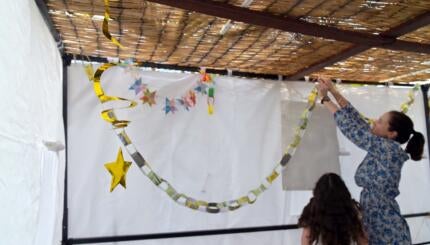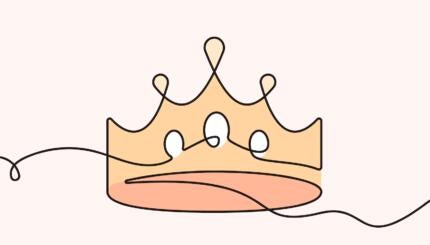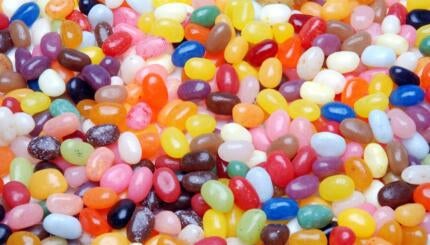Reprinted with permission from Iyyun, an institute for the exploration of the deeper dimensions of Torah.
Hanukkah is one of the most widely known and celebrated holidays of the year. It is festive, joyous, and family-oriented. It begins on the 24th of the Hebrew month of Kislev: a significant time of year–at least in the Northern Hemisphere–when the days are the shortest, and the climate the coldest.
In the summer months, people are generally more outgoing and in brighter moods. As the sunlight begins to decrease, people tend to become more introspective. The autumnal Hebrew month of Tishrei (occurring around September and October) is saturated with holy days such as Rosh Hashanah, Yom Kippur, and the festival of Sukkot. The next month, Cheshvan, has no holidays at all, and it is typically rainy and cold. 
This is when people are drawn further inward, and many desire to spend time alone. Kislev continues becoming darker and colder. People tend to retreat into their warm homes, and due to a subtle hibernation instinct in humans, we may actually sleep more than usual. Kislev culminates with the Winter Solstice, the longest night of the year. The following night is therefore minutely shorter–the first glimmer of light begins to re-awaken. At this season there’s a natural desire to join with family and friends and celebrate.
Every yom tov (Jewish holy day) has a natural, seasonal explanation, as well as a historical and spiritual story that gives rise to the celebration. When the Torah speaks of Pesah (Passover), for example, it defines the celebration as a commemoration of the story of the Exodus from Egypt. However, the Torah also says Pesah is to be celebrated in “the month of Aviv” (the first month of Spring), when harvesting begins. Thus, the content of the day–the narrative–is understood within a particular context, a specific season, with all its physical and psychological qualities. Before exploring the depths of the content of Hanukkah, let’s first delve more into the context, and the intricate interconnection between Hanukkah and its month and season.
With your help, My Jewish Learning can provide endless opportunities for learning, connection and discovery.
Re-awakening Light
When the Talmud, in Tractate Shabbat, begins to discuss Hanukkah, it first mentions the story: one small jug of oil, intended to burn for one night, lasted eight nights. Then it says, “On the following year they–our sages–established these days as holy days for singing praise and offering thanks.” In other words, the sages didn’t celebrate the miracles of Hanukkah right away. Only when the season came around again, did they perceive the nature of the previous year’s events. They sensed that the energies of these miracles were ‘established’–the miracles re-manifested, in a spiritual way, on the same dates of a following year.
By confirming the fact of this reappearance, our sages empowered us also to tap into the miraculous energy of Hanukkah that appears each year.
Why do we celebrate the miracles of Hanukkah and not other miracles? Why is there no holiday commemorating the manna or the miraculous well of Miriam? The answer is, we only celebrate past events when they can be re-experienced in the present.
It would seem that the annual re-appearance of the miraculous energy of Hanukkah is due simply to the cyclical patterns of time–there are certain patterns that rotate and return each year at the same time. However, in Jewish spirituality, we sense a linear movement of time as well.
Time is always progressing forward towards a spiritual culmination. Therefore, unlike the natural patterns of the year, the energies of Hanukkah progress toward a culmination, revealing something completely new each year. This linear movement joins the cyclical movement of nature to form an upward-spiraling, reawakening, ever-new light of Hanukkah.
The Name of the Month–Trust and Hope
Kislev is the ninth month of the year, counting from Nisan. In the Torah we find that the root of the word Kislev means ‘trust’ and ‘hope’: “Did I place my kili (my hope) in gold…?” (Job, 31:24) “…And they placed in Hashem their kislam (their trust).” (Psalms, 78:7)
Kislev therefore illustrates the issue of trust. When you make an appointment to meet someone, and they haven’t yet arrived, you can’t see them or know for certain that they’ll arrive on time. You can only see or envision their arrival by means of trust. When our days are dark and cold, we may not see the light and warmth of life clearly. Many people struggle with “seasonal affective disorder”, a form of depression attributed to the diminished sunlight of winter. After the Winter Solstice, the glimmer of light that arrives really does spark in us a trust in a brighter future.
In terms of the historical narrative of Hanukkah, the Hasmoneans had tremendous bitahon to stand up to their Roman oppressors. Despite the darkness of their time, they trusted in the miraculous. This inspired them to look at a defiled Temple and envision its re-purification. Because of this trust, their eyes were open enough to find a small measure of oil with which to kindle the Menorah.
Writing some two hundred years after the re-dedication of the Temple, Josephus calls Hanukkah “the Festival of Lights”. Although his historical accuracy is debatable, and he doesn’t even mention the miraculous oil, we can learn about Hanukkah’s theme of trust and hope from his account: “Perhaps the reason (for the name “Festival of Lights”) is that a freedom beyond our hopes appeared to us, and so this was the name given to the festival.” (Antiquities VII:7)
The Letter of the Month
Every point in the calendar has a unique energy, symbology, and opportunity for growth. The ancient text, Sefer Yetzirah, teaches that the month of Kislev corresponds to the letter Sameh, the astrological sign of Keshet or Sagittarius, and the rectification of “sleep”. What can we learn from these correspondences?
The letter Sameh literally means ‘to support or uphold’. When people have a deep trust that they are supported, even if they fall into darkness, they are able to bounce back.
The Sign of the Month
Sagittarius is a centaur with a drawn bow. A drawn bow is similar to the above image of ‘bouncing back’. The arrow is drawn backwards, and great tension is created. The bowsman trusts, however, that the deeper the arrow regresses, the further it will fly when released.
The Sense of the Month
Sleep, also, involves ‘descending’ into unconsciousness and vulnerability. An environment that is not trustworthy may keep a person from falling asleep. We tend to sleep only when we can trust that we will awaken.
When Sefer Yetzirah mentions “sleep”, it categorizes it as one of several hushim, ‘senses’–as in the senses of smell and sight. What does this mean? Some people have a chush–a refined ‘sense’ or taste for the art of sleeping. In contrast, others have a utilitarian relationship with sleep; they sleep because they’re tired or they seek an escape from the waking state. A ‘gourmet’ sleeper has deeper trust in Divine support, as the Book of Mishlei says, “If you rest, you will not worry; you will lie down and your sleep will be pleasant…, for you will trust Hashem.” (Mishlei 2)
When we lack trust, our minds are filled with self-centered worries, doubts, and the unfinished business of the day. This prevents deep, pleasant rest, and we may not ‘bounce back’ or awaken with energy for the next day. Therefore, to rectify the ‘sense’ of sleep, to make our sleep more God-centered and “pleasant”, we must refine our faculty of trust.
Prophetic Visions of Hanukkah
A few hundred years before the Hanukkah story, the First Temple fell and Jewish sovereignty was stripped from the Land of Israel. One 24th of Kislev during this dark time, the prophet Chagai spoke to his broken People. His words inspired them to expect and envision the magnificent rebuilding of the Temple.
Chagai spoke to the priests of the laws of purity–a prophetic hint, perhaps, to the pure jug of oil that would be found in the future, on the same date. Despite the bleakness of Winter, and the trauma and opposition they had survived, the People were filled with so much Divine trust, that they immediately began to rebuild the Temple.
Another prophet of those difficult times, Zechariah, transmitted to the People an image of purity and grandeur: he prophesied about a menorah of pure gold, flowing continuously with holy oil. Thus, long before the Hanukkah story, the menorah became a symbol of hope and light. Many centuries later too, the menorah became the symbol of the Jewish People, and a major theme in synagogue art and architecture.
A Primordial Hanukkah
The Talmud (Avodah Zarah, 8a) tells of a celebration of light during the time of year that would later become Hanukkah.
“When Adam–who was created in the beginning of the year, on the first day of Tishrei–noticed that during the first three months of his life, the days were getting gradually shorter, he said, ‘Woe is to me! Because I’ve sinned, the world around me is being darkened and is returning to its state of chaos and confusion; this must be the kind of death which has been sentenced to me from Heaven!’ He took upon himself to pray, fast, and look within. After eight days, he noticed the Winter Equinox (the Tekufat Tevet, the season of the month of Tevet), and saw that indeed the days were beginning to lengthen again. “So this is the way of the world!” he exclaimed, and he celebrated for eight days.”
The Darkest Night
The Winter Solstice generally occurs during the last week of Kislev. Therefore, not only does the week of Hanukkah contain the longest night of the year, but at the end of a lunar month the nights have virtually no moonlight.
A student of the Baal Shem Tov named Rabbi Yakov Yosef determined, through complex calculations, that the night of the Hanukkah victory and the re-lighting of the Menorah was precisely the longest night of the year. This deepest darkness sets the stage for the greatest possible revelation of light.
Divine Light

The light that comes from fire is dependent on the burning and destroying of something else. Divine light, however is self-derived. At the Burning Bush, Moses encounters Divine light. It shines like a fire, and yet the bush is not consumed. This light doesn’t necessarily take away the darkness–it somehow shines within the darkness. This is the “Ohr HaGanuz“, the ‘Hidden Light’, the Divine light that burns within the darkness of Creation, yet doesn’t consume Creation. It is the light of Hanukkah revealed in the darkest nights of the year and the darkest times of exile. Thus, the small jug of oil lit by the kohanim didn’t consume any oil.
When people are inspired they can rise to meet great challenges. These are times when the pure “oil” of a person’s soul shines brightly. Sadly, however, such peak experiences of inspiration wane, and most people return to the comfort of darkness.
The “miracle” of Hanukkah was that the Jews were able to shine brightly for eight nights, extending beyond the natural cycle of a week. If Hanukkah began on a Sunday, the last night was also Sunday again, and yet they were illumined as if it were the first night. The brilliance actually filled them throughout the whole year, and therefore they established that the inspiration and illumination of Hanukkah would continue to manifest every year, for all generations.
Every Hanukkah is a special time for revealing the Hidden Light. Unlike all the Torah–based holidays, however, at the end of the Rabbinic holiday of Hanukkah there is no havdalah, or ritual of separation. May we never separate from the timeless light of Hanukkah. May it permeate every moment of our lives.
Hanukkah
Pronounced: KHAH-nuh-kah, also ha-new-KAH, an eight-day festival commemorating the Maccabees' victory over the Greeks and subsequent rededication of the temple. Falls in the Hebrew month of Kislev, which usually corresponds with December.
Kislev
Pronounced: KISS-lev, Origin: Hebrew, Jewish month usually coinciding with November-December.
menorah
Pronounced: muh-NOHR-uh, Origin: Hebrew, a lamp or candelabra, often used to refer to the Hanukkah menorah, or Hanukkiah.
Talmud
Pronounced: TALL-mud, Origin: Hebrew, the set of teachings and commentaries on the Torah that form the basis for Jewish law. Comprised of the Mishnah and the Gemara, it contains the opinions of thousands of rabbis from different periods in Jewish history.
Torah
Pronunced: TORE-uh, Origin: Hebrew, the Five Books of Moses.


